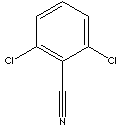2,6-DICHLOROBENZONITRILE
PRODUCT IDENTIFICATION
1194-65-6

CLASSIFICATION
PHYSICAL AND CHEMICAL PROPERTIES
143 - 146 C
AUTOIGNITION
NFPA RATINGS
REFRACTIVE INDEX
APPLICATIONS
·
Extraction solvent for fatty acids,
oils and unsaturated hydrocarbons
· Solvent for spinning and casting and
extractive distillation based on its selective miscibility with organic
compounds.
· Removing agent of colouring matters and aromatic
alcohols
· Non-aqueous solvent for titrations and for inorganic
salts
· Recrystallization of steroids
·
Parent compound for organic
synthesis
· Solvent or chemical intermediate in biochemistry ( pesticide
sequencing and DNA synthesis)
·
High-pressure liquid chromatographic
analysis
· Catalyst and component of transition-metal complex
catalysts
· Stabilizer for chlorinated
solvents
· Chemical intermediate and solvent for perfumes and
pharmaceuticals
Benzonitrile, derived mainly from benzoic acid reaction with lead thiocyanate by heating, is a clear liquid; boils at 191 C; It reacts violently with strong acids to produce toxic hydrogen cyanide. It decomposes on heating producing very toxic fumes, hydrogen cyanide, nitrous oxides. Benzonitrile is used as a solvent and chemical intermediate for the synthesis of pharmaceuticals, dyestuffs and rubber chemicals through the reactions of alkylation, condensation, esterification, hydrolysis, halogenation or nitration. Benzonitrile and its derivatives are used in the manufacture of lacquers, polymers and anhydrous metallic salts as well as intermediates for pharmaceuticals, agrochemicals, and other organic chemicals. 2,6-Dichlorobenzonitrile is used in formulating herbicides and for the synthesis of other chemical intermediate.
APPEARANCE
99.5% min
143 - 146 C
0.5% max